Vietnam cities exhibit a rich array of cultural diversity and geographical wonders. From bustling metropolises in the south to charming historical towns in the center and adventure hubs in the north, each region offers unique experiences. Discover the vibrant street life of Ho Chi Minh City, delve into the ancient allure of Hue, or trek through the breathtaking landscapes of Sapa. Whatever your interests, Vietnam promises unforgettable adventures and enriching encounters with its diverse traditions and landscapes.
See more: Explore Vietnam’s Exquisite Destinations
Contents
South Vietnam Cities
Ho Chi Minh City
Ho Chi Minh City, also known as Saigon, stands as Vietnam’s largest city and is poised to become a megacity in the near future. It serves as a pivotal economic and entertainment hub, alongside its status as one of Vietnam’s two primary cultural and educational centers. Situated within the special urban category of Vietnam, Ho Chi Minh City currently comprises 16 districts, 1 city, and 5 districts, encompassing a total area of 2,095 km2, with a population of 9,389,700 people.

Located within the sub-equatorial tropical monsoon region, Ho Chi Minh City shares the climatic traits common to Southern provinces. Characterized by uniformly high temperatures year-round and distinct rainy and dry seasons, the city’s climate significantly shapes its environmental landscape. The rainy season spans from May to November, while the dry season extends from December to April of the subsequent year.
Ho Chi Minh City serves as an ideal destination for cultural enthusiasts, boasting a diverse populace of 44 ethnic minorities out of 53 in Vietnam. Predominant ethnic groups include the Chinese, Cham, Khmer, and Tay communities.
Key attractions within Ho Chi Minh City include:
- Ben Thanh Market: A renowned tourist hotspot situated in the city center, known for its bustling atmosphere and diverse offerings.
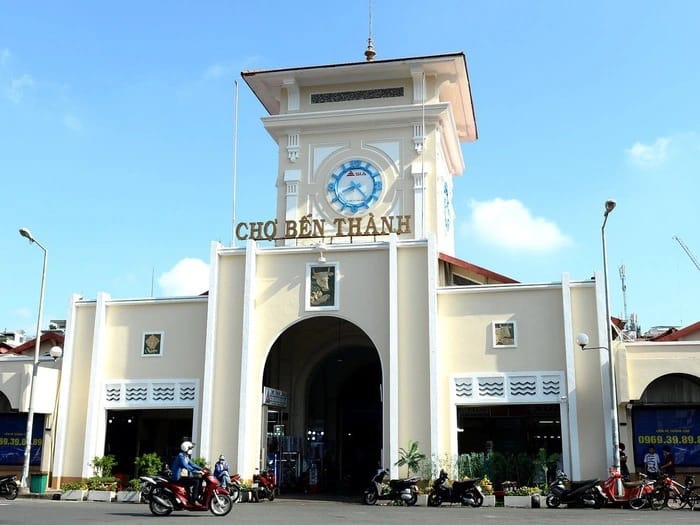
Ben Thanh Market in Ho Chi Minh – Source: Collected - Independence Palace (Reunification Hall): A historical landmark dating back to the French colonial era, designated as one of Vietnam’s 10 special national monuments.
- Notre Dame Cathedral: A prominent architectural gem in District 1, reflecting European influences and serving as a significant site for Catholic worship.
- Cu Chi Tunnels: Located approximately 70km from the city center, this historical relic is a popular attraction, particularly among foreign tourists, offering insights into Vietnam’s wartime history and serving as a testament to the resilience of its people during the Vietnam War.

Can Tho City:
Can Tho stands as one of Vietnam’s five centrally administered cities, serving as the bustling and highly developed nucleus of the Mekong Delta. It holds pivotal roles in the economic, cultural, social, medical, educational, and commercial spheres within the region.
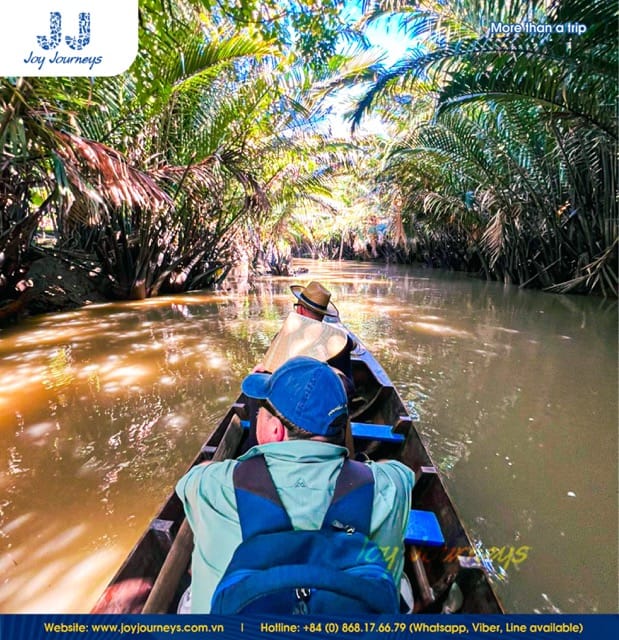
Located 169 km from Ho Chi Minh City and spanning a distance of 60-190 km from surrounding provinces in the Mekong Delta, Can Tho City occupies a central position within the lower Mekong Delta. Stretching over 65 km along the west bank of the Hau River, it encompasses a natural area of 1,401 km2, housing a population of 1,297,260 people according to the 2023 census data.
For visitors to Can Tho, notable attractions include:
- Cai Rang Floating Market:
- Recognized as the largest floating market in the West and designated as a national intangible cultural heritage in 2016, Cai Rang Floating Market offers a vibrant trading atmosphere on boats, showcasing the region’s renowned agricultural products and fruits such as Vinh Long Nam Roi grapefruit, Tra Vinh wax coconut, Lai Vung tangerine, and Cai Mon durian.

Cai Rang Floating Market
- Recognized as the largest floating market in the West and designated as a national intangible cultural heritage in 2016, Cai Rang Floating Market offers a vibrant trading atmosphere on boats, showcasing the region’s renowned agricultural products and fruits such as Vinh Long Nam Roi grapefruit, Tra Vinh wax coconut, Lai Vung tangerine, and Cai Mon durian.
- Truc Lam Phuong Nam Zen Monastery:
- Renowned as a prominent spiritual tourist destination in Can Tho, Truc Lam Phuong Nam Zen Monastery ranks among the largest Zen monasteries in the Southern region.
- Featuring distinctive architecture, including a main hall tiled with eight roofs reminiscent of the Tran Dynasty’s architectural style, and a main hall tiled with four roofs following the Ly Dynasty’s design, the monastery exudes a sense of serenity.
- The centerpiece of the monastery is a 3.5-ton bronze statue of Sakyamuni Buddha, flanked by intricately carved statues of Bodhisattva Pho Hien and Bodhisattva Manjushri, embodying artistry and spirituality.
Vung Tau City, Ba Ria – Vung Tau
Vung Tau, situated in Ba Ria – Vung Tau province within the Southeast region of Vietnam, stands as a prominent tourist destination in Southern Vietnam. Functioning as the logistics hub for Vietnam’s oil and gas industry, this coastal city lies 125km southeast of Ho Chi Minh City, covering an area of 1,989.56 km2 with a population of 1,176,078 as of 2021.

Attractions to explore upon arrival in Vung Tau include:
- Statue of Jesus Christ the King: Serving as a symbol of the coastal city, this statue of Jesus stands atop Nho Mountain in Vung Tau. With a height of 32 meters and arms spanning 18.4 meters, the statue rests on a pedestal adorned with depictions of God and the 12 apostles. Inside, a spiral staircase with 133 steps leads visitors to the statue’s neck, offering panoramic views of the cityscape after ascending the 1,000 steps.
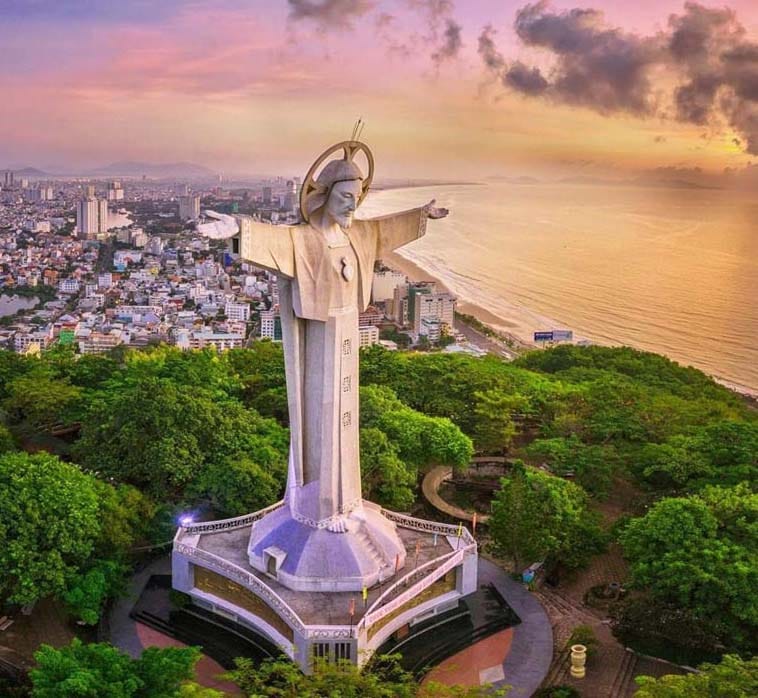
Jesus Christ the King – Must Visit Place in Vung Tau – Source: Collected - Vung Tau Lighthouse: Regarded as an emblematic landmark of Vung Tau, this lighthouse, the oldest of its kind in Vietnam and Southeast Asia, boasts a cylindrical tower standing 18 meters tall and 3 meters in diameter, painted in pristine white. Ascending the stairs inside the lighthouse grants visitors a panoramic vista of Vung Tau city. Accessible by car, motorbike, or by traversing the mountain trail on foot, it offers a unique perspective of the city.
Central Vietnam Cities
Da Nang city
Da Nang, positioned as one of Vietnam’s five centrally administered cities, resides within the South Central Coast region, serving as the central and largest city in the entire Central region. It plays a pivotal role as a significant nucleus within the Central Key Economic Region.
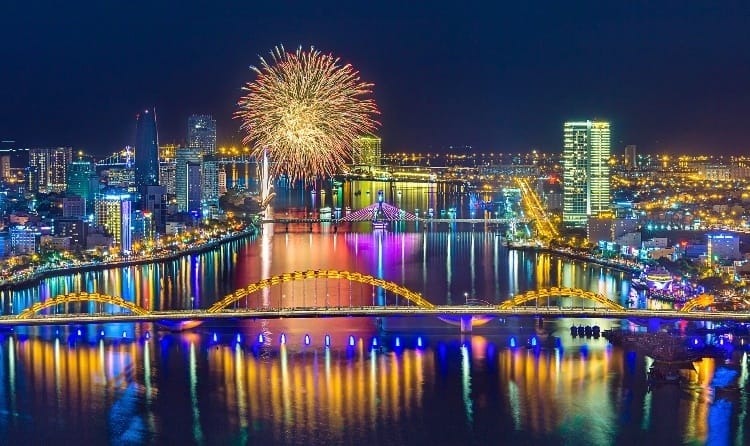
In 2018, Da Nang earned the distinction of representing Vietnam in the list of the 10 best places to live abroad, as voted by the travel magazine Live and Invest Overseas (LIO).
Covering an area of approximately 1285 km2 and boasting a population of around 1,188,374 as of 2022, Da Nang exudes a captivating allure for visitors.
Top attractions to explore in Da Nang include:
- Dragon Bridge: Located in the An Hai Tay Ward of the Son Tra District, the Dragon Bridge, operational since 2013, stands as a novel tourist destination in Da Nang. Spanning the picturesque Han River with its distinctive dragon-shaped design, it is the seventh bridge contributing to the city’s iconic “city of bridges” status. Visitors can witness vibrant displays of dragons breathing fire and water during weekend visits.
- Marble Mountains: Situated at 81 Huyen Tran Cong Chua, Hoa Hai, Ngu Hanh Son, Da Nang, the Marble Mountains, known locally as Ngu Hanh Son, comprise six mountains: Kim Son, Moc Son, Thuy Son, Tho Son, Hoa Son (Duong Hoa Son and Am Hoa Son). These limestone mountains, juxtaposed against the coast, offer a unique blend of mountainous terrain, seaside vistas, and spiritual sanctity, drawing both domestic and international tourists for exploration. Recognized as a national historical-cultural relic, Marble Mountains ranks among the top ten prominent tourist destinations in Da Nang.
- My Son Sanctuary: Located in the Duy Phu commune of the Duy Xuyen district, Quang Nam province, the My Son Sanctuary stands as a compelling tourist attraction near Da Nang. Recognized by UNESCO as a World Cultural Heritage site in 1999, this destination showcases the unique architectural legacy of the ancient Champa civilization. Visitors are treated to an array of ancient Champa structures, offering insights into the rich cultural heritage of the region.

My Son Sanctuary – UNESCO Heritage near Da Nang – Source: Collected
Hue
Hue, serving as the capital city of Thua Thien Hue province, Vietnam, holds historical significance as the former capital of Vietnam during the Tay Son dynasty (1788–1801) and Nguyen dynasty (1802–1945). Presently, it stands as a pivotal center for culture, tourism, specialized healthcare, education and training, as well as science and technology within the Central Region – Central Highlands and the entire country.

Hue experiences distinct seasons, characterized by a rainy season and a low-rainy season, without a significant dry season. The rainy season typically extends from March to August, marked by hot and muggy conditions. Subsequently, from September to January of the following year, the city experiences cooler temperatures during the rainy season. Notably, October to November coincides with the storm season, accompanied by heavy and persistent rainfall.
Key attractions in Hue include:
- Dong Ba Market: Established in 1899, Dong Ba Market stands as a symbol of the ancient capital, bustling with activity year-round. Stretching from Gia Hoi Bridge to Truong Tien Bridge, the market boasts thousands of stalls offering a vibrant array of goods. Visitors can immerse themselves in the colorful atmosphere, exploring delectable cuisine and browsing unique items such as clothes, fabrics, hats, fish sauces, and cakes that are exclusive to Hue.
- Hue National School: Established during the reign of King Thanh Thai in 1896, Hue National School is the first high school in Hue. Located at 12 Le Loi Street in the city center, the school’s distinctive red façade and lush greenery contribute to its charm and historical significance.

Hue National School – Source: Collected - Hue Citadel: Encompassing more than 100 remarkable architectural marvels, including Ngo Mon, Thai Hoa Palace, Dien Tho Palace, Truong Sanh Palace, Hung Mieu, and The Mieu, Hue Citadel stands as a testament to the city’s rich heritage and imperial legacy.
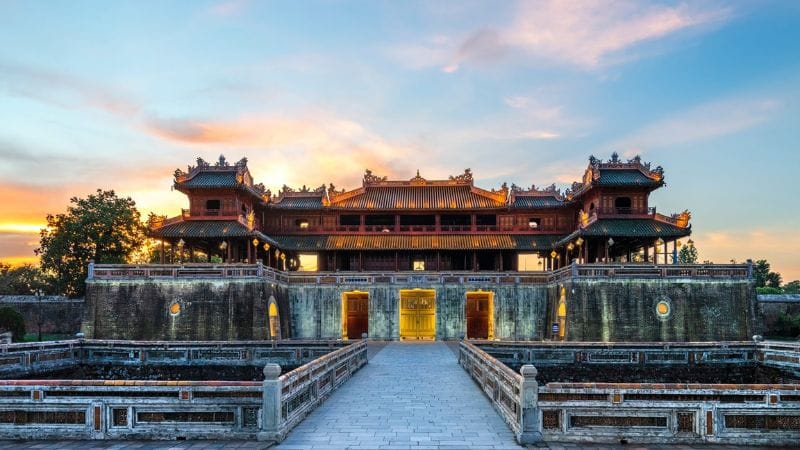
Hue Cidatel – SOurce: Collected
Hoi An, Quang Nam
Hoi An, located in Quang Nam province, Vietnam, boasts a rich cultural heritage as the former bustling international trading port of Hoi An ancient town. Recognized by UNESCO as a World Cultural Heritage site since 1999, it showcases architectural marvels dating back centuries.

Presently, the city is home to five traditional craft villages, housing nearly 50 active craft industries, including carpentry, pottery, lantern making, bamboo and coconut crafts, garment production, and leather crafting. Among these, three craft villages and one traditional craft have been acknowledged as National Intangible Heritage, with two additional craft villages in the process of seeking recognition.
Notable destinations to explore in Hoi An include:
- Covered Bridge: This iconic landmark attracts numerous tourists with its distinctive architecture featuring a wooden canopy adorned with Japanese-inspired motifs. Known colloquially as the Japanese Bridge, it symbolizes the essence of Hoi An’s tourism.
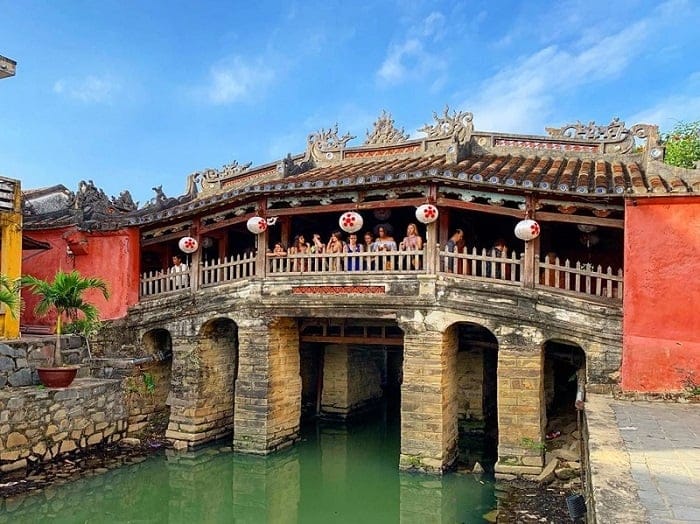
Japanese Bridge – Source: Collected - Hoi An Market: A hub for purchasing souvenirs and local specialties, Hoi An Market offers a wide array of Hoi An and Quang Nam specialties, handicrafts, and delectable dishes.
- Hoi An Lantern Festival: Celebrated in the ancient town, the Lantern Festival serves as a cultural preservation activity, showcasing the local traditions and beliefs. Lanterns, symbolizing peace and prosperity, adorn the streets, and visitors can partake in the mesmerizing tradition of releasing lanterns onto the Hoai River, symbolizing wishes for happiness and prosperity.
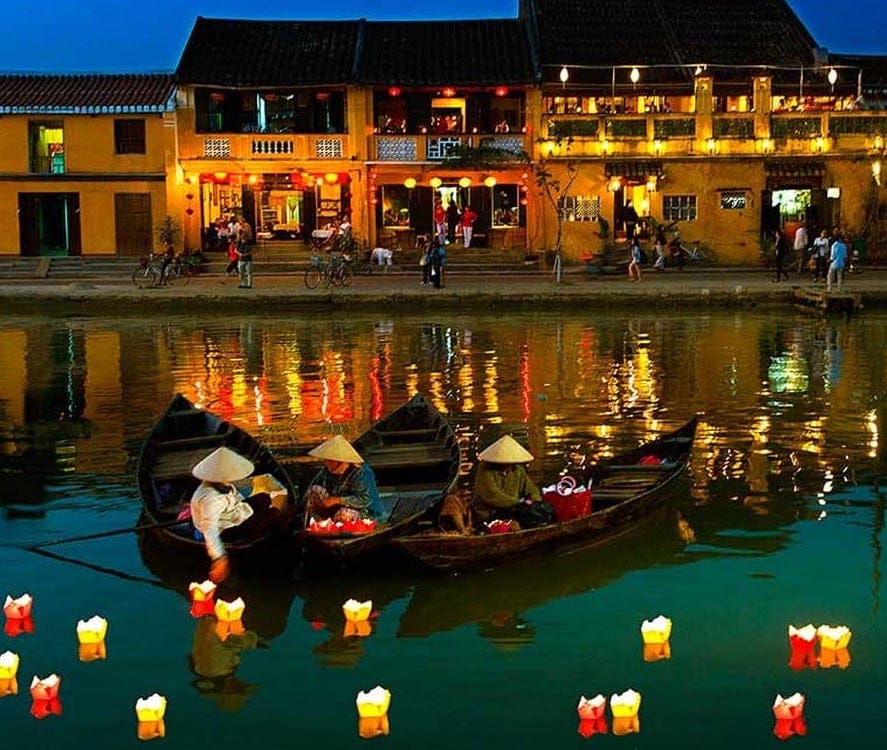
Lantern Festival in Hoi An – Source: Collected
North Vietnam Cities
Ha Noi
Hanoi, the capital and centrally administered city of the Socialist Republic of Vietnam, stands as one of the nation’s two special urban areas. As the largest city in Vietnam in terms of area, Hanoi serves as a prominent cultural, entertainment, and sporting hub, hosting numerous important venues and events, both political and international. Additionally, it boasts a significant concentration of traditional craft villages and is renowned for its multitude of festivals in Northern Vietnam.
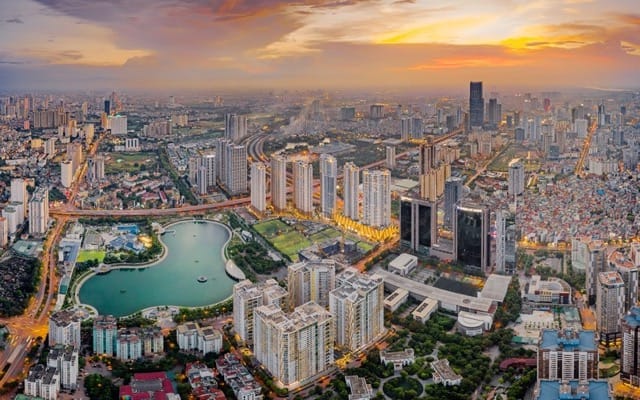
Covering an expansive area of 3,359.82 km², Hanoi is home to approximately 8.5 million people according to the General Statistics Office’s 2024 data.
Top destinations to explore in Hanoi include:
- One Pillar Pagoda: An exceptional ancient architectural masterpiece, the One Pillar Pagoda’s construction date remains a subject of historical debate. Constructed primarily of wood, it features a unique square Lotus pedestal atop a 4-meter-high column.
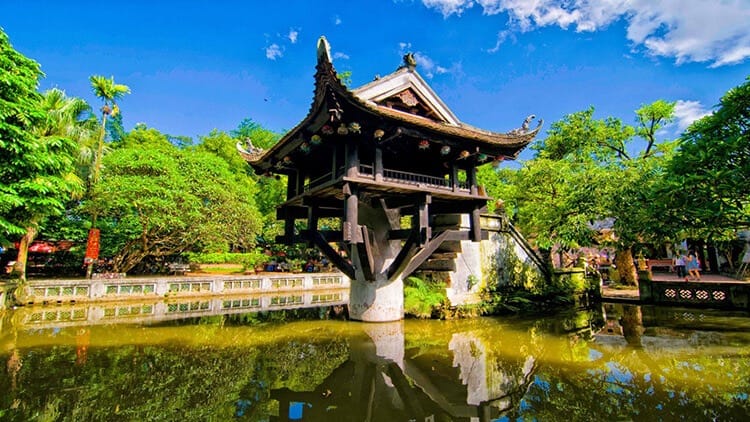
One Pillar Pagoda – Source: Collected - Ba Dinh Square and President Ho Chi Minh’s Mausoleum:
- A historical landmark not to be missed, Ba Dinh Square holds significance as the site where President Ho Chi Minh proclaimed the declaration of independence, marking the establishment of the Socialist Republic of Vietnam.
- Within the main square lies Uncle Ho’s Mausoleum, housing the preserved body of President Ho Chi Minh. Open to visitors on Tuesday, Wednesday, Thursday, Saturday, and Sunday mornings, the Mausoleum imposes certain regulations, including dressing appropriately, refraining from using recording devices, and maintaining decorum within the premises.
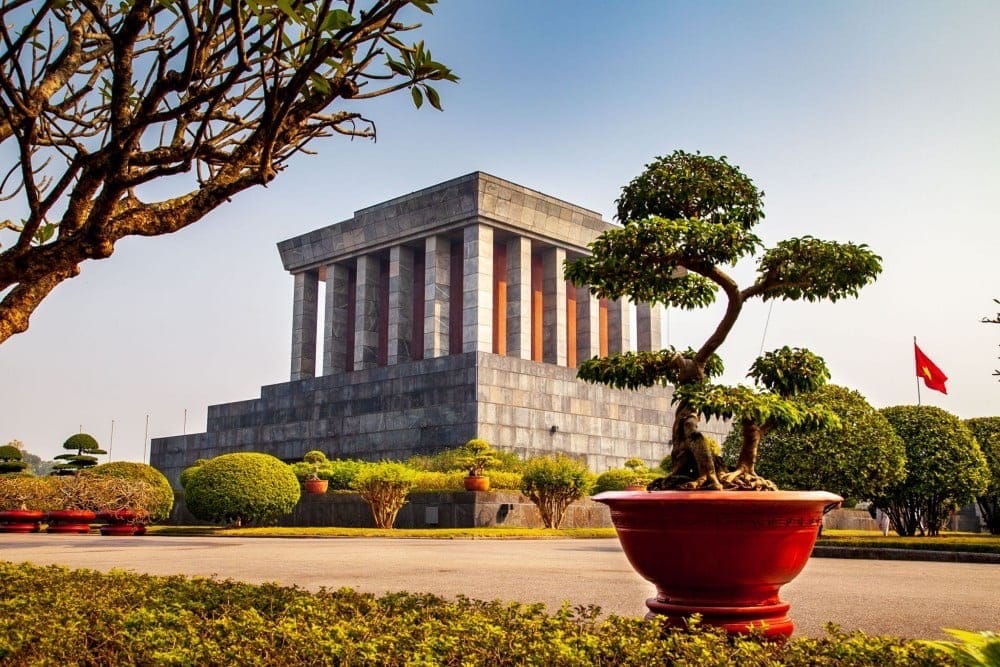
Ha Long
Ha Long, serving as the capital city of Quang Ninh province, Vietnam, derives its name from Ha Long Bay, a renowned natural heritage site located south of the city. Positioned at the heart of Quang Ninh province, Ha Long city lies approximately 165 km east of the center of Hanoi, the capital city.

Spanning an area of 1,119.36 km², Ha Long city boasted a population of 300,267 individuals as of 2018, with a population density of 268 people per square kilometer.
Top destinations to explore in Ha Long include:
- Ha Long Bay: Recognized as one of the New Seven Natural Wonders of the World and designated as a UNESCO World Natural Heritage site, Ha Long Bay is renowned for its breathtaking beauty. Notable attractions within Ha Long Bay include Sung Sot Cave, Thien Cung Cave, Ti Top Island, Cua Van Fishing Village, Hang Luon, Hon Trong Mai, and Bai Tu Long Bay, each contributing to the allure and symbolism of Ha Long.
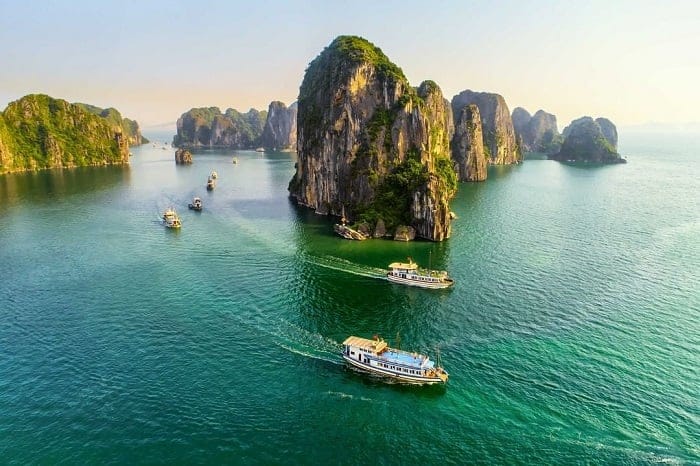
Ha Long Bay – Source: Collected - Tuan Chau Island, Quang Ninh: Tuan Chau Island stands as a haven for resort-goers, captivating tourists with its mesmerizing natural landscapes resembling enchanting watercolor paintings. Encompassing an area of approximately 400 hectares, the island lies approximately 2 kilometers from the center of Ha Long city, offering visitors a tranquil retreat amidst scenic beauty.

Tuan Chau Island, Ha Long – Source: Collected
Crafting Your Dream Vietnam Itinerary
Crafting your ideal itinerary for Vietnam requires thoughtful consideration of your travel style, preferences, and available resources. Here’s a guide to help you plan your dream trip to this captivating destination:
Define Your Travel Style:
- History Buff: Immerse yourself in Hanoi’s Old Quarter, explore the Imperial Citadel in Hue, and delve into the Cu Chi Tunnels near Ho Chi Minh City.
- Beach Bum: Relax on pristine beaches in Phu Quoc or Nha Trang, soak up the sun in Da Nang, and kayak through the emerald waters of Ha Long Bay.
- Adventure Seeker: Trek through Sapa’s majestic rice terraces, conquer Mount Fansipan (the “Roof of Indochina”), and explore Phong Nha Ke Bang National Park’s hidden caves.
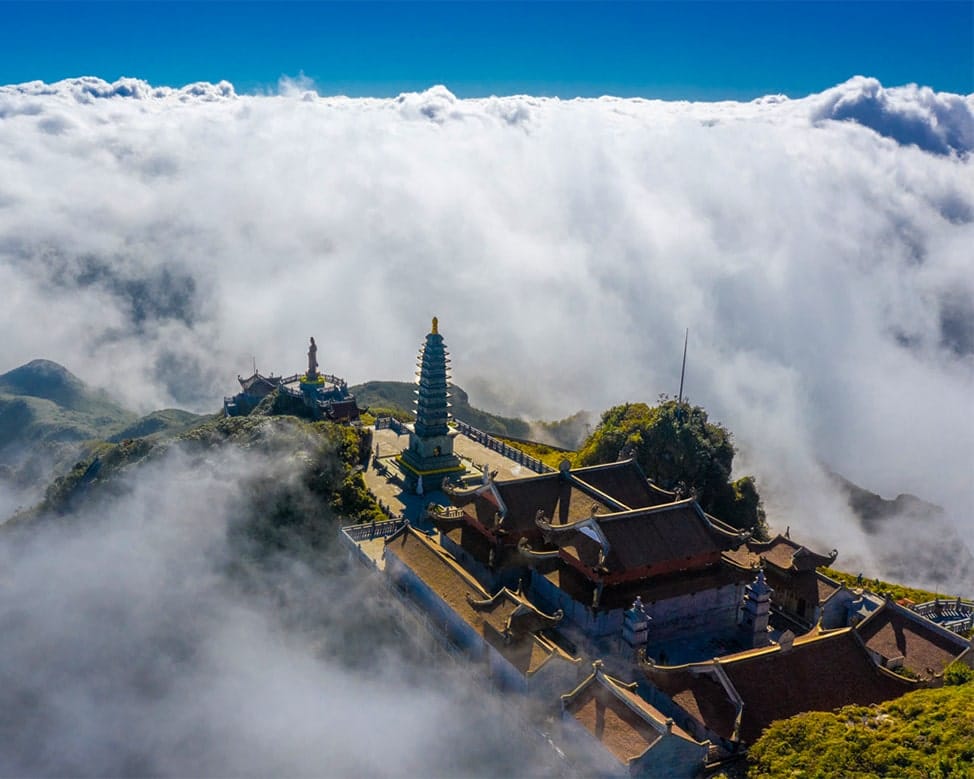
Fansipan is Suitable for Travelers who seeking for adventurous – Source: Collected - Foodie: Take a street food tour in Hanoi, learn to cook traditional dishes in Hoi An, and indulge in fresh seafood along the Mekong Delta.
Budget and Duration:
- Backpacker: Opt for budget-friendly hostels, utilize local transportation, and explore street food stalls.
- Luxury Traveler: Choose high-end hotels, splurge on private tours, and indulge in upscale dining experiences.
- Cities: Include a few days in Hanoi and Ho Chi Minh City to experience Vietnam’s dynamic urban landscapes, historical sites, and vibrant nightlife.
- Countryside: Immerse yourself in the serenity of Sapa’s rice terraces, explore the unique cultures of ethnic minorities in Mai Chau, or cycle through the picturesque countryside near Hoi An.
- Coasts: Relax on the beaches of Phu Quoc or Nha Trang, take a boat cruise through Ha Long Bay or explore hidden coves in Cat Ba Island.
Transportation:
- Flights: Utilize domestic airlines like Vietnam Airlines or VietJet Air for quick connections between major cities.
- Trains: Enjoy scenic journeys on the Reunification Express train or the scenic Ha Long Bay – Sapa route.
- Buses: Opt for comfortable sleeper buses for longer distances or local buses for shorter trips within regions.
- Local Transportation: Rent motorbikes for adventurous exploration, hail taxis for convenient travel, or try cyclos (rickshaws) for a unique city experience.
Activities:
Many tours and activities can be booked online in advance through platforms like Klook, GetYourGuide, TripAdvisor.
- Guided Tours: Explore iconic landmarks like Cu Chi Tunnels or the Imperial Citadel with knowledgeable guides.
- Cooking Classes: Learn to cook traditional dishes like Pho or Banh Mi from local experts.

Vietnamese Traditional Dish Cooking Class - Cultural Experiences: Participate in homestay programs, attend water puppet shows, or visit local markets.
- Outdoor Adventures: Book trekking expeditions, kayaking tours, or cycling adventures for an adrenaline rush.
Conclusion
In conclusion, navigating Vietnam’s cities offers a tapestry of experiences, blending rich history, vibrant culture, and diverse landscapes. By tailoring your itinerary to encompass bustling metropolises like Hanoi and Ho Chi Minh City, charming historical towns like Hoi An, and serene coastal escapes like Da Nang, you can create a comprehensive exploration of Vietnam’s urban tapestry. With careful planning and utilization of essential resources, your journey through Vietnam’s cities promises unforgettable encounters and lasting memories.
Frequently Asked Questions
1.What time is it in Ho Chi Minh City, Vietnam?
Ho Chi Minh City (HCMC) is GMT+7 (UTC+7). This means it is 12 hours ahead of Pacific Standard Time (PST) and 17 hours ahead of Coordinated Universal Time (UTC) during standard time.
2. What is the capital city of Vietnam?
The capital city of Vietnam is Hanoi.
3. Where is Ho Chi Minh City in Vietnam?
Ho Chi Minh City (HCMC) is located in southern Vietnam. It’s the largest city in the country and a major commercial center.
4. Which city is best to go to in Vietnam?
There’s no single “best” city in Vietnam – it depends entirely on your travel preferences! Here’s a quick guide:
- History and Culture: Hanoi and Hue offer a rich historical tapestry.
- Beaches and Relaxation: Phu Quoc, Nha Trang, and Da Nang boast stunning beaches.
- Adventure: Sapa and Ha Long Bay are perfect for trekking and exploring.
- Foodie Paradise: Any city will have amazing food, but Hanoi and Hoi An are particularly renowned.
5. What are the three major cities in Vietnam?
The three major cities in Vietnam are:
- Hanoi: The capital city, rich in history and culture.
- Ho Chi Minh City (HCMC): The largest city, known for its bustling atmosphere and modern development.
- Da Nang: A coastal city offering beaches, historical sites, and the Marble Mountains.
6. Where is the most beautiful city in Vietnam?
Beauty is subjective! Each city in Vietnam has its own unique charm. Here are a few contenders:
- Hoi An: Known for its colorful lanterns and charming ancient town.
- Ha Long Bay: Offers breathtaking scenery with towering limestone formations.
- Sapa: Features stunning rice terraces and mountain landscapes.
7. What is the 4th largest city in Vietnam?
The 4th largest city in Vietnam is Can Tho, located in the Mekong Delta region. It’s famous for its floating markets and canals.


Related Posts
Saigon’s “Flower Market Replica”: Where To Find Them
Ho Chi Minh City’s floral charm is not limited to its bustling wholesale markets. Imagine wandering through a place where vibrant petals, fragrant blooms, and the spirit of traditional Vietnamese markets come alive—without the overwhelming crowds. A flower market replica captures that magic, blending the beauty of fresh flowers with the charm of a curated, […]
Is it Safe to Travel to Vietnam Right Now? A Complete 2025 Guide
Vietnam has emerged as one of Southeast Asia’s most captivating destinations, drawing millions of visitors annually with its rich culture, stunning landscapes, and incredible cuisine. However, many travelers still ask: Is it safe to travel to Vietnam right now? This comprehensive guide provides you with everything you need to know about Vietnam travel safety in […]
Ho Chi Minh Cu Chi Tunnels Tour: The Ultimate Guide
The Cu Chi Tunnels stand as one of Vietnam’s most remarkable historical sites, offering visitors a profound glimpse into the ingenuity and resilience displayed during the Vietnam War. For travelers, a Ho Chi Minh Cu Chi tunnels tour represents an essential experience that combines education, adventure, and deep cultural understanding. This comprehensive guide will help […]